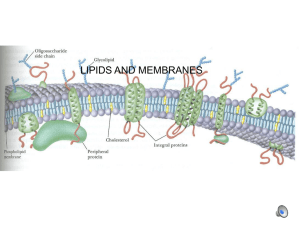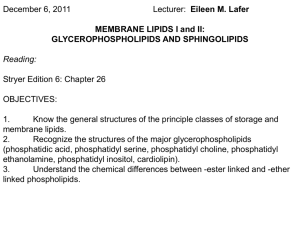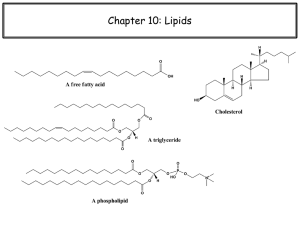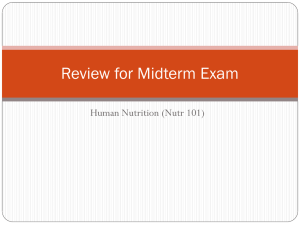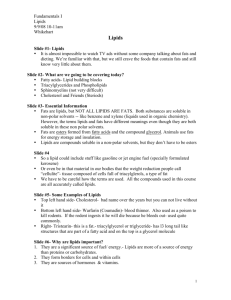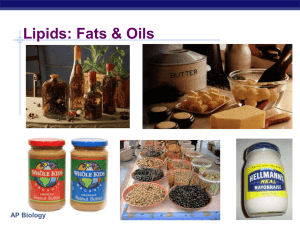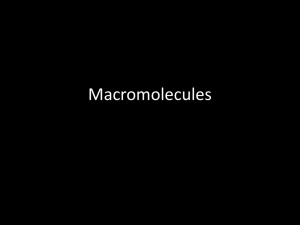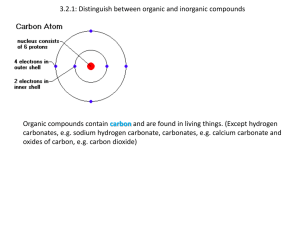Complex_Lipids_2012
advertisement
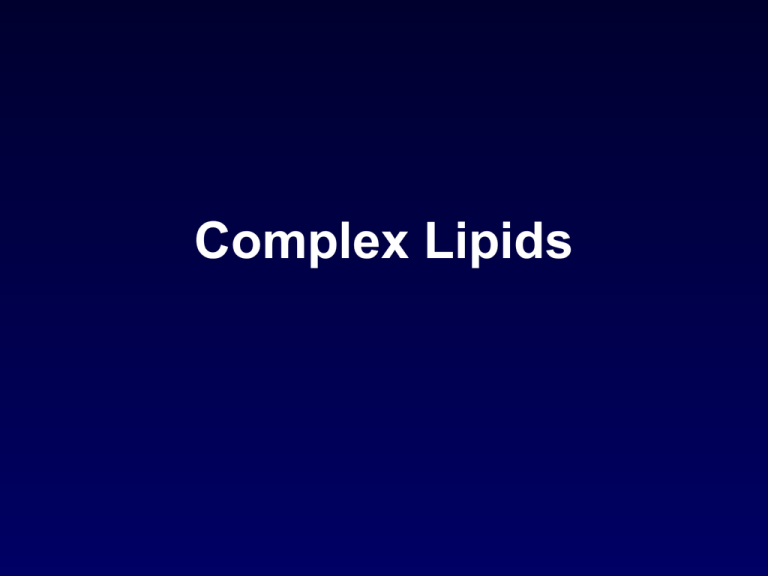
Complex Lipids Vignette 3 • Introduction: A 3 week premature baby boy born to a diabetic mother by cesarean section. • Presenting complaints: Bluish discoloration of the skin and mucus membranes (cyanosis) with apnea. • Examination: Unusual breathing movement -- drawing back of chest muscles with breathing. APGAR score less than 5 • Investigations: lecithin/sphingomyelin ratio of amniotic fluid at 34th week of gestation = 1.2 • Laboratory investigations: Blood gas analysis of baby indicates low oxygen and excess acid in the body fluids. Blood culture negative for infection. • Diagnosis: Acute respiratory distress syndrome (ARDS)/ Infant respiratory distress syndrome (IRDS) Classification - (Structure) LIPIDS SIMPLE LIPIDS Fats and Oils Waxes Glycerophospholipids COMPLEX LIPIDS Phospholipids Sphingophospho lipids Cerebrosides Glycolipids Globo- Gangliosides sides Sulfatides Simple Lipids FATTY ACID FATTY ACID FATTY ACID Triacylglyceride Complex lipids: phospholipids Glycerophospholipids FATTY ACID FATTY ACID P HEAD GROUP Ether Glycerolipids O- ETHER FATTY ACID P HEAD GROUP Complex lipids: Phospholipids Glycerophospholipids Ether Glycerolipids Sphingophospholipids Complex lipids: Sphingophospholipids OSINE FATTY ACID P HEAD GROUP Glycerophospholipids Phosphatidic acid FATTY ACID FATTY ACID P Glycerophospholipids (16:0, 18:0) (18:1, 18:2, 18:3) Phosphatidylcholine Lung surfactant = 90% lipids (Dipalmitoylphosphatidylcholine, DPCC; Dipalmitoylecithin) + 10% protein Cardiolipin Diphosphatidylglycerol Distribution: Inner mitochondrial membrane Function: Maintenance of respiratory complexes Ether Glycerolipids Plasmalogens Distribution: Phosphatidalethanolamine (in nerve tissue) Phosphatidalcholine (in heart muscle) Function: More resistant to oxidative stress therefore provides protection to tissues with active aerobic metabolism Platelet-activating factor Distribution Released by a variety of cell types, including platelets, neutrophils, basophils, and endothelial cells. Functions PAF activates inflammatory cells and mediates hypersensitivity, acute inflammatory, and anaphylactic reactions. Phosphatidylinositol (PI) Stearic acid (18:0) Arachidonic acid (20:4) Distribution present in all tissues and cell types. Especially abundant in brain tissue, (10% of the phospholipids). Functions: Cell signaling, Reservoir of arachidonic acid Protein anchoring Phosphatidylinositol 4, 5 – bisphosphate (PIP2) Protein anchoring Sphingophospholipids Sphingophospholipids Sphingosine 2-amino-4-octadecene-1,3-diol C-18 alcohol containing two –OH groups, one amino group and one double bond Sphingomyelin Distribution Constituent of the myelin sheath of nerve fibers. Functions Building block of myelin sheath Primary source of ceramide Signal transduction Phospholipids - Degradation Niemann-Pick disease • autosomal recessive disease • inability to degrade sphingomyelin. • deficiency of sphingomyelinase - a type of phospholipase C. Glycolipids/glycosphingolipids Glycolipids/glycosphingolipids OSINE FATTY ACID CARBOHYD RATE Glycolipids/glycosphingolipids CEREBROSIDES GLOBOSIDES GANGLIOSIDES SULFATIDES Distribution essential components of all membranes in the body. greatest amounts in nerve tissue Functions regulation of cellular interactions, growth, and development Blood group antigens Cerebrosides • ceramide monosaccharides -simplest neutral glycosphingolipids • Galactocerebroside - the most common cerebroside found in membranes • Glucocerebroside - serves primarily as an intermediate in the synthesis and degradation of the more complex glycosphingolipids. • cerebrosides are found predominantly in the brain and peripheral nervous tissue, with high concentrations in the myelin sheath Galactocerebroside Globosides • Ceramide oligosaccharides • Addition of monosaccharides (including GalNAc) to a glucocerebroside e.g. Cer-Glc-Gal (lactosylceramide) Cer-Glc-Gal-Gal-GalNac-GalNac (Forssman antigen) Gangliosides • Negatively charged at physiological pH • Glycolipids containing sialic acid (N-acetylneuraminic acid, NANA) • found primarily in the ganglion cells of the central nervous system, particularly at the nerve endings Gangliosides Nomenclature • is based on the number of sialic acid residues o 'GM' a single (mono) sialic acid, o GD, GT and GQ two, three and four sialic acid residues in the molecule, respectively • on the sequence of the carbohydrates. o The number after the GM, e.g. GM1 refers to the structure of the oligosaccharide. o These numbers were derived from the relative mobility of the glycolipids on thin layer chromatograms; the larger, GM1, gangliosides migrate the most slowly. Sulfatides • cerebrosides that contain sulfated galactosyl residues • negatively charged at physiologic pH • found predominantly in nerve tissue and kidney Sphingolipidosis • Defects in sequential degradation of glycolipids lead to a number of lysosomal storage diseases, Sphingolipidosis (cerebrosidoses and gangliosidoses) • A specific lysosomal hydrolytic enzyme is deficient in each disorder. Therefore, usually only a single sphingolipid (the substrate for the deficient enzyme) accumulates in the involved organs in each disease THE END!
